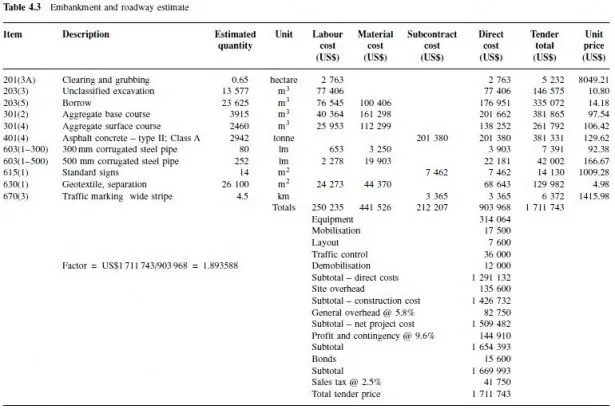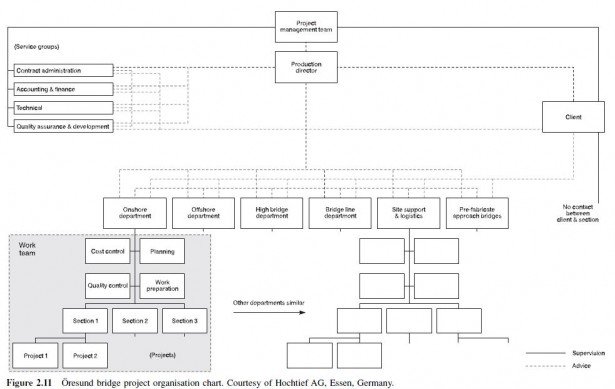During this final stage of the design phase, all of the previous effort is transformed into documents that will form the basis for the construction contract. When this stage is completed, the contractor, or contractors, can be selected, after which the work involved in procuring and assembling the physical parts can begin. The term contract can refer either to the formal agreement signed by the parties, usually the owner and the contractor, or to this agreement plus a multitude of other documents that are referenced by the agreement. Thus, when we talk about the contract documents, we include three types: (1) the technical specifications, which describe the project, its materials and its methods or performance requirements, (2) the so-called up-front documents that describe the relationships and responsibilities of the parties (including at least the agreement, general and special (or supplementary) conditions, invitation to tender, instructions to tenderers, form for submitting the tender and bond documents) and (3) the drawings, which are scaled and dimensioned graphic depictions of the project features, usually with notes that explain related details. The technical specifications and the up-front documents are typically part of a project manual distributed to prospective tenderers for use in the contractor selection process and to guide the successful tenderer during on-site construction. It is the designers responsibility to produce all of these documents or to assemble them if they are furnished by the owner, during this, the contract document development stage. The bases for many of these documents have been developed over many years by various national and international organisations; these so-called standard forms and conditions are used in both private and public construction projects. On the international level, FIDIC, to which we referred briefly in Chapter 2, provides many resources useful for designers preparing contract documents for construction projects. FIDIC was founded in 1913 by the national consulting engineering organisations of Belgium, France and Switzerland (F´ed´eration Internationale des Ing´enieurs-Conseils, 2001b); today it consists of the member associations of 67 countries, representing some 560 000 professional engineers. Among the member associations are the Association of Consulting Engineers in the UK, the Consulting Engineers Association of India and Camara Argentina de Consultores. The Federation publishes standard forms of contract documents used in the procurement of building and engineering works. Of special interest here are three sets of documents: (1) Conditions of Contract for Construction, used when the owner or the owners designer provides the design, which is then built by a construction organisation, (2) Conditions of Contract for Plant and DesignBuild and (3) Conditions of Contract for EPC/Turnkey Projects (F´ed´eration Internationale des Ing´enieurs- Conseils, 2000). Each set includes general conditions, guidance for preparing particular (special) conditions, example bond security forms, letter of tender forms, a contract agreement and a dispute adjudication agreement, all of which will be discussed in a general way in subsequent sections herein.
In addition to the internationally recognised standard documents promulgated by FIDIC, many countries have developed such contract materials. Standards New Zealand, the trading arm of the New Zealand Standards Council, a crown entity established in 1938, publishes Conditions of Contract for Building and Civil Engineering Construction (Standards New Zealand Paerewa Aotearoa, 1998). This publication, developed and updated by a broad-based construction industry committee, is utilised throughout New Zealand for most construction projects, both public and private. It includes general conditions of contract; schedules to the general conditions including suggested special conditions, an agreement, surety bond forms and insurance certificates; conditions related to the tendering process; a series of guidelines for utilising the document; and a general aid to evaluating the costs of changes in the work. Individual owners have the choice of using this document or some other, but in reality it is used almost universally within New Zealand. A quotation from the foreword is instructive (Standards New Zealand Paerewa Aotearoa, 1998):
A major advantage of using a standard conditions of contract is that its provisions are well known and understood. It does not need to be searched for project specific changes buried within every time a tender is priced or construction is being managed.
Construction industry associations in the USA have produced a large number of standard contract documents. For building construction, the American Institute of Architects (AIA) and the Associated General Contractors (AGC) have been active in this area for many years. While choices of document forms may be important, such efforts can also lead to unnecessary duplication. In recent years, AIA and AGC have collaborated to produce common documents for construction management types of delivery systems. For public works, bridges and power stations in the USA, documents promulgated by the Engineers Joint Contract Documents Committee are often used; this committee was established by several prominent professional engineering and construction societies (Dorsey, 1997). Furthermore, the American Association of State Highway and Transportation Officials (AASHTO) furnishes a standard format for highway construction specifications that is used by most states in the USA (Fisk, 2003).
Instead of using standard documents such as those described above, many construction projects use non-standard documents developed by individual design or owner organisations. For example, a consulting firm might use its own documents for its projects, tailoring them as needed for any particular project. Such materials are sometimes referred to as master documents (Robbins, 1996). At the other extreme, the contract documents might be produced anew for an especially complex project with many irregularities; it is unlikely, however, that a completely new document would be invented for even such a project.
Having introduced the sources from which construction contract documents can be obtained and having mentioned the names of many of those documents, we now define and describe the salient features of each of the especially important types.

